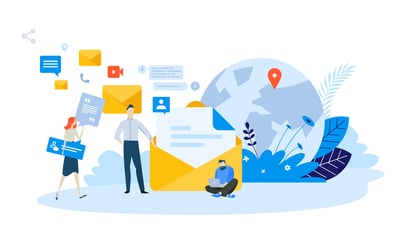October 30, 2019
 by Jonathan Herrick / October 30, 2019
by Jonathan Herrick / October 30, 2019

Are you getting maximum utility out of your email marketing efforts?
Most likely, the answer is no. Regularly checking up on your conversion rates is one way to confirm that your efforts are working, but in order to obtain a truly big-picture view of how well your emails are performing, implementing a complete email marketing audit is necessary.
An effective email marketing audit gives you an inside look at your deliverability rates, open rates, engagement, and more. And equally (or perhaps more) importantly, it provides you with insight on how to do better. And as marketers, if you’re not consistently trying to improve your efforts, then your efforts are pretty useless.
If you’re like most small businesses and marketing agencies, you’re probably not keeping tabs on your emails quite as well as you should be. With so many other things to do—like, you know, composing those emails in the first place—key details like contact list hygiene often get left by the wayside.
However, performance is everything when it comes to email marketing strategy, and it pays to take the time to audit your efforts and see what’s working and what’s not. Plus, doing so can help foster efficiencies down the line, eventually creating more time for you check more things off your to-do list.
You may be thinking that doing a complete email marketing audit is going to take a lot of time and require all hands on deck. The truth is, your marketing automation platform can help perform some of the legwork. Since all your information is stored there, all you have to do is divide and conquer.
Here are some easy-to-follow instructions for tackling your email marketing audit with grace, ease, and efficiency.
The best place to start your email marketing audit is your contact list. Email servers take things like bounce rates and spam flags very seriously, and if you’re consistently ending up in dead-end inboxes you may eventually struggle to end up in any inboxes at all. Queue instant panic.
Most email marketing platforms make it easy for you to see which email addresses are bouncing and who has marked you as spam. Go through the list and make a note of any email addresses that are invalid or have indicated that they consider you a spammy site. You want to make sure not to message them because even if they are real people, no one is benefitting from those outreach efforts and reaching out would be a waste of your time anyway.
As an added tip, operate on an opt-in only basis when building your email contact list (aside from people who explicitly say they want to hear from you). Reaching out to someone without the proper opt-in option (i.e. sneaking in permission to reach out to them with further information) will not only create distrust between your brand and customers, but it also isn’t GDPR compliant.
|
TIP: Using a tool like G2 Track to keep your compliance in check can be the difference between massive fines and smooth sailing. Learn more today. |
When you give your customers control and the option to opt-in, you’re letting them make the decision of whether or not they want the customer relationship to take the next step. This permission-based email marketing will provide you with more buy-in from them and start the nurture off on the right foot.
While you’re auditing your contact list, why not take the time to input some segmentation as well? Segmenting your email recipients by key consumer demographic factors like age, geographic location, and industry will assist you in reaching the right people with the right messages.
Segmenting allows you to be more strategic with your email marketing campaigns. You can send personalized content to your contacts based on what it is they do, what their pain points are, and what they need to overcome any obstacles they’re experiencing.
So instead of just sending the same exact content to all your leads, this will allow you to look at where they are in the buyer’s journey, take into consideration their industry and the type of company they work for, and send them applicable content that is tailored more towards their needs. You will show them you are a reliable resource that they can depend on for specific educational information.
Your email marketing platform can help you perform this segmenting and targeting. Many platforms give you segmentation suggestions that take the guesswork out of assigning addresses to the right lists. If your platform doesn’t provide suggestions, however, simply create lists based on industry or whatever other demographics you’re pulling that you find valuable, and target those customers with content that is applicable.
Eliminating inefficiencies in email marketing requires that you take a deep look at your workflow process and modify it as needed. What steps do you take between email conception to execution? How long does each step in the process take? Are there any steps that are holding you back, like requiring edits and approvals from several different people?
The goal here is to streamline the process as much as possible. If you’re working with a marketing automation platform, you’ll have less room for error with your workflow, and thus less of a reason to go through a complicated process to get your emails out. If a step doesn’t absolutely need to be there, eliminate it and put more focus into the tasks that really make a difference.
Just because you’ve used a particular process for a while doesn’t mean you have to continue to carry it out. Like goals, processes can change and evolve, and if it makes more sense to have fewer team members involved in something or to remove or condense tasks, then do it. You can always adjust again after your next audit, but either way, putting efficiency at the forefront of your email marketing efforts will save you time in the long run.
This one seems like a given, but a lot goes into understanding what exactly lends itself to effective deliverability. Email deliverability is one of the cornerstones of successful email marketing, and everything from your subject line to the placement of your “unsubscribe” button plays a role in whether or not you end up in a recipient’s inbox—and if you’re not getting in the inbox, you’re definitely not converting in other areas.
Some easy tips to improve email deliverability: authenticate your domain, and add the required email security protocols, personalize your subject lines and content, and include links instead of attachments if you’re directing recipients to additional assets. These are just basic tips that every email marketer should be implementing, and they don’t take much time at all.
Aside from contributing to deliverability, taking these steps will also improve the quality of your emails. Your customers will be delighted when you send them personalized content that will help them do their jobs better, and it will keep your emails concise, clean, and easy to engage with.
Look to your email marketing analytics for lessons about what type of content converts your audience. Are your recipients drawn in by videos? Promotions? Quick tips and how-tos? Whatever content that’s working is what you should be capitalizing on for maximum gains and conversions.
As a rule, the best email marketing content has three important aspects: it is personalized, informational, and value-driven. Today’s consumers are fickle, and if you’re sending them something they’re not interested in, they’re going to opt-out of additional messaging. Aim for brevity and interest with your content, and always offer something for your readers’ time, be it a coupon, a piece of actionable advice, or just something that you know they’ll find interesting.
Take a look at your click-through rate and the open rate. If these are decreasing, look into what you’re doing in your emails that may be contributing to that. Maybe there are issues with the quality or quantity of your images. Maybe it’s the time of day you’re sending the email. Or maybe it’s the amount of content you’re putting in the emails that is disengaging your audience.
Whatever it is, figure out some tactics that allow you to optimize your content and showcase it in a way that is more digestible and interesting to your readers, then check in on the open rate and click-through rate again to see if it has made a difference.
An email marketing audit will take some time—it shouldn’t be a one-and-done activity. But, if you use the full capabilities of your marketing automation tool, you’ll be able to make the process fairly painless. Regardless, setting a schedule for regular audits every quarter is wise to detect if anything isn’t working, so that you can easily locate the issue.
There’s a lot to be gained from doing email marketing right—and a lot to lose from doing it wrong. Prioritize audits and you’ll have a much better handle on where you’re succeeding and where you need to make an adjustment.
Discover the right email marketing software for your needs on G2 to ensure you stay at the top of your email marketing strategy.
Jonathan Herrick is CEO and chief high-fiver at Benchmark Email and BenchmarkONE, bringing together 130 employees serving over 150,000 users in 15 countries and nine languages worldwide.
Email is one of the go-to forms of communication for many companies who want to connect with...
 by Michael Bibla
by Michael Bibla
Email marketing enables brands to contact prospective customers regularly and create trusting...
 by Maria Fintanidou
by Maria Fintanidou
Personalization isn't a new term in email marketing — we've heard a lot about it from time to...
 by Aishwarya Ashok
by Aishwarya Ashok
Email is one of the go-to forms of communication for many companies who want to connect with...
 by Michael Bibla
by Michael Bibla
Email marketing enables brands to contact prospective customers regularly and create trusting...
 by Maria Fintanidou
by Maria Fintanidou


